Our Saviour's Lutheran Church
27201 99th Ave. NW
Stanwood, WA
Note: Not extant. Not playable. (in this location)
Images
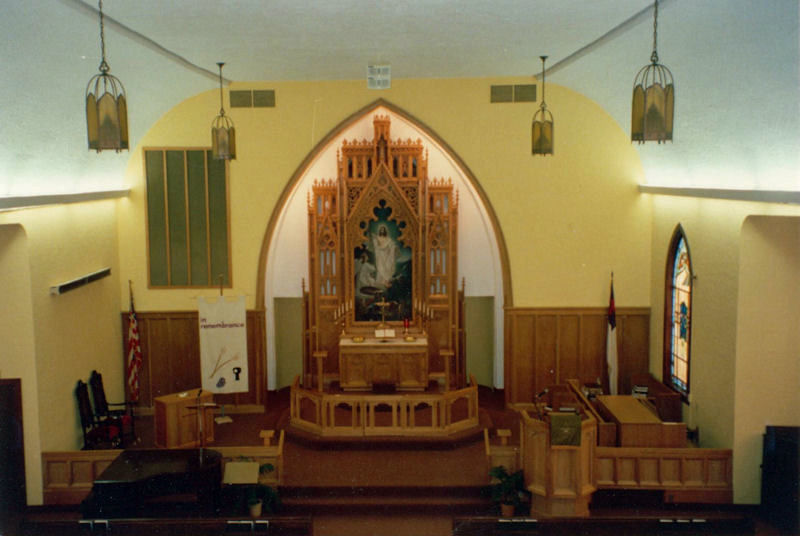 Unknown - Sanctuary Interior, Chancel, and Chamber Grillework (left) (Photograph by James R. Stettner (1991)/Database Manager)
Unknown - Sanctuary Interior, Chancel, and Chamber Grillework (left) (Photograph by James R. Stettner (1991)/Database Manager)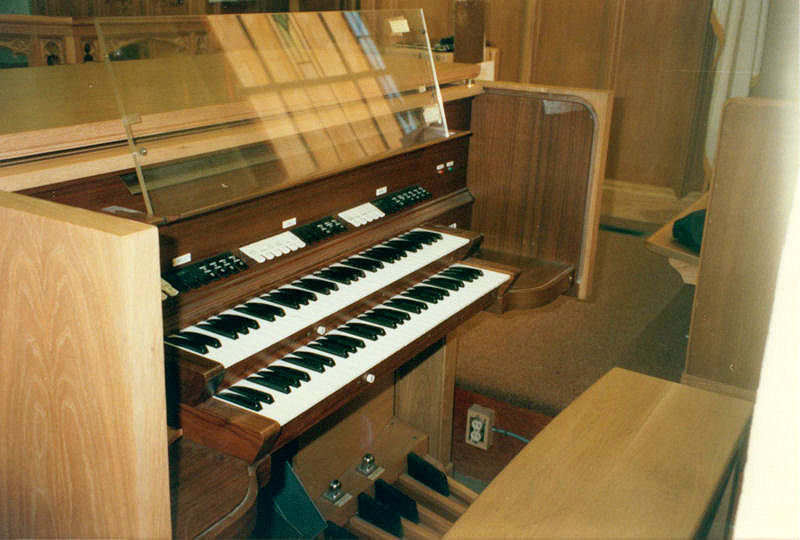 Unknown - Console (Photograph by James R. Stettner (1991)/Database Manager)
Unknown - Console (Photograph by James R. Stettner (1991)/Database Manager)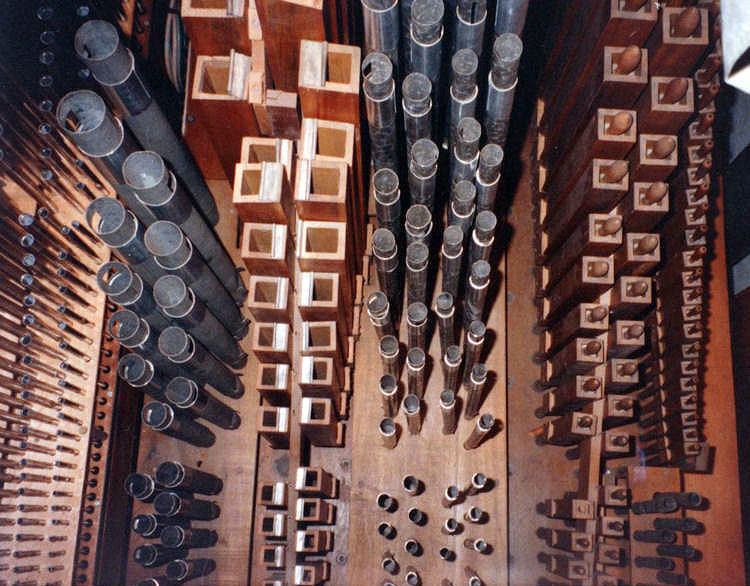 Unknown - Original Kimball Pipwork and Chest (l-r): 8' Open Diapason, 8, Melodia, 8. Dulciana, 8' Gamba, 8' Stopped Diapason, 4' Flute d'Amour (Photograph by James R. Stettner (1991)/Database Manager)
Unknown - Original Kimball Pipwork and Chest (l-r): 8' Open Diapason, 8, Melodia, 8. Dulciana, 8' Gamba, 8' Stopped Diapason, 4' Flute d'Amour (Photograph by James R. Stettner (1991)/Database Manager)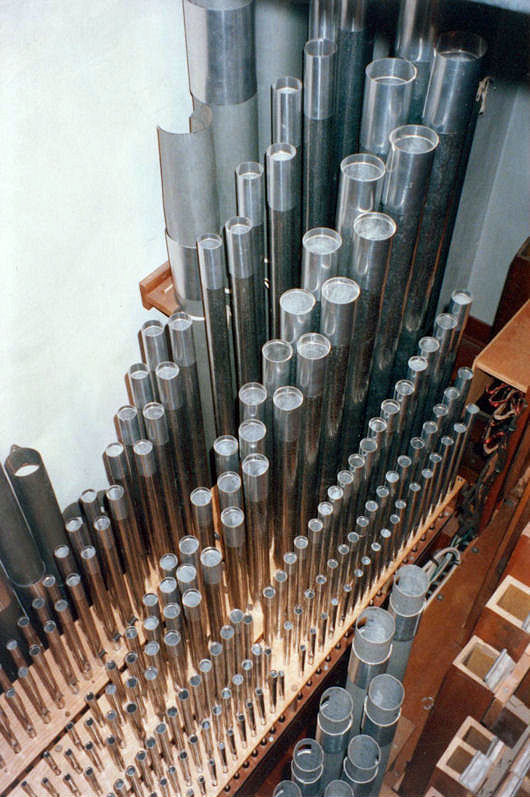 Unknown - Added Pipework (l-r): 4' Octave, 8' Principal, III Mixture (Photograph by James R. Stettner (1991)/Database Manager)
Unknown - Added Pipework (l-r): 4' Octave, 8' Principal, III Mixture (Photograph by James R. Stettner (1991)/Database Manager)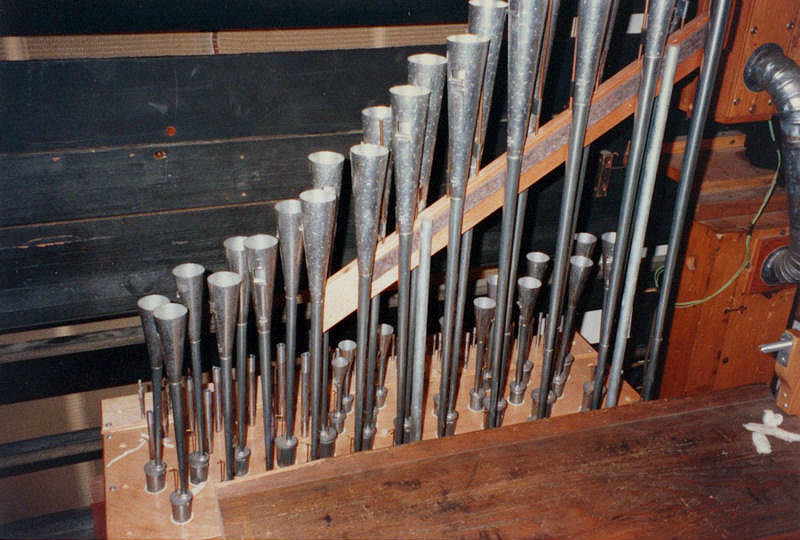 Unknown - Pipework (added 8' Oboe) (Photograph by James R. Stettner (1991)/Database Manager)
Unknown - Pipework (added 8' Oboe) (Photograph by James R. Stettner (1991)/Database Manager)
Consoles
Main
- 2 manuals
- 11 stops
- 13 registers
- 3 divisions
- Key action Type: Electrical
- Stop action Type: Electrical
- Manual compass: 61 notes
- Pedal compass: 32 notes
- Has crescendo
- Has coupler thumb pistons
- Has coupler toe pistons
Notes
2006-11-28 - Identified through online information from James R. Stettner. -- Tonal revisions and additions to the existing ca. 1909 transplanted Kimball, previously electrified by Balcom and Vaughan in 1956. The added Swell 8' Vox Humana was replaced by a new Oboe. And a new Salicional was added to the Swell with the original Gamba being rescaled as a Voix Celeste. On the Great, a new 4' Octave and III Mixture were added. The Pedal remained unchanged from the 1956 electrification. -Database Manager
Stoplist
Original document from James R. Stettner. Source: Stoplist copied from the console October 7, 1992 2017-01-17
Stanwood, Washington
Our Saviour's Lutheran Church
W.W. Kimball Co., ca. 1909
Balcom and Vaughan, Opus 627, 1956 - Electrification
Balcom and Vaughan Pipe Organs, Inc., Opus 627A, 1974 - tonal additions, new console
GREAT (Expressive) COUPLERS
8' Open Diapason (*) 61 Swell to Pedal 8,4
8' Melodia (*) 61 Great to Pedal 8,4
8' Dulciana (*) 61
4' Octave 61 Swell to Great 16,8,4
III Mixture [19-22-26] 183
Great to Great 16' FINGER PISTONS
Great Unison Off Sw. to Ped. (rev)
Great to Great 4' Gt. to Ped. (rev)
3 blank, black stoptablets
TOE STUDS
Sw. to Ped. (rev)
SWELL (Expressive) Gt. to Ped. (rev)
8' Stopped Flute (*) 61
8' Salicional 61
8' Voix Celeste (*) 61 PEDAL MOVEMENTS
4' Flute d'Amour (*) 61 Expression (bal.)
8' Oboe 61 Crescendo (bal.)
Tremulant
Swell to Swell 16'
Swell Unison Off
Swell to Swell 4'
3 blank, black stoptablets ACTION: E-P ventil & unit
VOICES: 11
PEDAL (Expressive)
16' Bourdon (*) 30 STOPS: 13
16' Gedeckt –-
8' Flute 14 RANKS: 13
3 blank, black stoptablets PIPES: 776
NOTES
The original congregation's name was Stillaguamish Norwegian Lutheran Church. This was
subsequently changed to Trinity Norwegian Lutheran Church. The first church building
was location at Main and Market Streets. The first organ was a I-manual Moline reed
organ with 16 stops which was saved from the May, 1892 fire which razed the structure.
Also saved were the bell and some furnishings. The Moline organ is still extant in the
present building.
The present church was built in 1892-93, and as dedicated on August 12, 1894. The Moline
organ served the parish until 1913 when a I-manual tubular-pneumatic pipe organ built by
the Estey Organ Co. of Brattleboro, Vermont was installed. It was their opus 1107. The
cost of the instrument was $1,200.00, and it was paid for in cash! A photo of the church
interior made from a glass negative shows the organ located on the front, left side of
the chancel area with an attached keydesk and 14 pipes of the Great 8' Open Diapason in
the façade.
According to the church's published history on the occasion of their 100th Anniversary
((1976, pg. 15) the choir sponsored the purchase of a new pipe organ in 1934. The cost
of this instrument was also $1,200.00 A trade-in allowance was made for the Estey.
Professor Nickel of Luther College and Professor Werner of the University of Washington
were the guest recitalists. Research has revealed the organ was used, and had originally
been built by the W.W. Kimball Co. of Chicago, Illinois for the Society (later, Broad-
way) Theatre in Seattle, Washington. It was a 2-manual, 8-rank tubular-pneumatic instru-
ment. It was relocated and installed at Our Saviour's Lutheran by Kimball representative
Arthur D. Longmore of Seattle.
In 1956, the organ was electrified by Balcom and Vaughan of Seattle, Washington. A new
console was to have been part of the project, but funds were insufficient so the Kimball
keydesk remained. A 25-note set of Maas electronically amplified Carillonic Chimes was
added at this time. Their compass was tenor F thru f 42. The chimes were presented by
Mrs. Andrew L. Leknes as a memorial to her husband. October 21, 1956, the 80th
Anniversary, was celebrated with an organ concert to dedicate the rebuilt organ and
chimes.
The 1974 rebuild and enlargement of the organ, again by Balcom and Vaughan Pipe Organs,
Inc., finally included a new console and some new windchests for four new sets of pipes
comprising six ranks. New regulators were also provided. Stops marked with an asterisk
(*) in the preceding specification are the original Kimball ranks. The Swell 8' Voix
Celeste was the original 8' Gamba. The original Pedal compass was 30 notes, so the
original 16' Bourdon was augmented with 14 wooden, stoppered, double-mouthed pipes
marked, “Gr Dop. Fl. 2456.” The Pedal 16' Gedeckt is the same as the 16' Bourdon, but
with pipes 1 – 12 on soft wind.
When the church acquired another used and much larger organ in 2008-09, the existing
organ was removed by Marceau and Associates of Seattle and ultimately broken-up for
parts.
Sources: B&V opus list and files, Eugene M. Nye compilation; JRS; extant organ
Related Pipe Organ Database Entries
Other Links
Regrettably, it is not possible to display the information about the sponsor of this pipeorgandatabase entry or if there is a sponsor. Please see About Sponsors on Pipe Organ Database.




